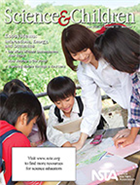Ecosystems: Interactions, energy, and dynamics
By Mary Bigelow
Posted on 2014-03-06
 In an NSTA discussion forum, a question was raised about studying ecosystems and food chains at the elementary level. I pointed the readers to articles in this month’s edition of Science & Children, which has a variety of classroom resources and background information for teachers.
In an NSTA discussion forum, a question was raised about studying ecosystems and food chains at the elementary level. I pointed the readers to articles in this month’s edition of Science & Children, which has a variety of classroom resources and background information for teachers.
Many science lessons for young students focus on warm, fuzzy animals. Our World Without Decomposers: How Scary!* describes a series of class activities in which students examine and learn about “bugs, slugs, bacteria, and fungi.” (My middle schoolers would love this, too!) Descriptions of creating a classroom decomposing tank, exploring decomposers a local park, and reflecting on the role these organisms play in an ecosystem are the highlights of this article. [SciLinks: Decomposer, Characteristics of Fungi, Bacteria, Composting, How Does Nature Recycle Materials]
Videos, readings, and classroom activities are good, but nothing beats real outdoor experiences. Ecosystems, Up Close and Personal (The Early Years)* shows how just about any schoolyard can be an ecosystem. When students plant seeds in a school garden or even in a pot, they can begin to understand the relationship between a living thing and the abiotic factors in an ecosystem. A lesson is provided. [SciLinks: How do ecosystems change naturally?, Plant Growth]
Regardless of whether you call them pillbugs or roly-polies, The Amazing Ecology of Terrestrial Isopods* show how these arthropods can be the basis for an engaging study of interactions between organisms and their environment. The authors include a fact sheet on these critters and a description of an outdoor activity in which students observed the organisms and the characteristics of their environment. The students then created an indoor habitat (directions provided) in which they could investigate the behaviors of these low-maintenance classroom animals in more detail. [SciLinks: Arthropods]
Do your students understand that a food chain is more than a diagram of who eats what? If Energy is Neither Created Nor Destroyed, What Happens to It? (Science 101) discusses the energy transfer in an ecosystem. [SciLinks: Food Chains, Food Webs]
Not all evidence and data are numeric. With the prevalence of digital cameras and cell phone cameras, students have an evidence-collecting tool at their fingertips. Exploring Nature Through a New Lens* has suggestions for a student study of the schoolyard habitat. And if you’re thinking about turning part of the school campus into an outdoor learning center, you’ll want to read Ensuring a Safer Outdoor Experience (Safety First)*.[SciLinks: Habitats]
The authors of How Healthy Is Our Pond?* provided students with a real-life scenario for studying the characteristics of a local pond. Students observed the physical and biological surroundings and performed water quality tests for temperature, pH, nitrates, dissolved oxygen, and clarity. The authors describe these tests in detail and include photographs and samples of student data. [SciLinks: Water Quality]
Growing Gardens, Growing Minds* shows how K-4 students went beyond growing seeds in paper cups to designing a community garden at their school. They also learned about nutrition and how plants are part of a healthy diet. The article includes photographs and a grade-by-grade description of class activities related to the project. Seeding Science in Elementary Schools (Methods and Strategies) describes a school-university partnership to establish classroom gardens. [SciLinks: Plants as Food, Plants with Seeds, Seed Germination]
“Adaptation” is a word that can have several meanings, from its everyday one to a more scientific one. Habitat Change: Formative Assessment of a Cautionary Word (Formative Assessment Probes) includes a probe to study students’ perceptions of the process. [SciLinks: Adaptations of Plants, Adaptations of Animals]
Is This Alive? (Science Shorts)* is a question that intrigues students. How do we know? The 5E lesson here focuses on kindergarten students’ explorations of living things and some of their misconceptions. [SciLinks: Living Things]
Let’s Talk Trash (Teaching Through Trade Books)* suggests two trade books on the topic and includes two lessons that help students look at their own choices and how these choices can affect their communities. The 5E lesson Garbage Gurus (K-2) guides students through an analysis of “trash” to determine what might be recyclable. For students in grades 3-5, the 5E lesson Where Does Our Trash Go? examines the trash stream in their community. [SciLinks: Recycling K-4, Recycling 5-8]
*And check out more Connections for this issue (March 2014). Even if the article does not quite fit with your lesson agenda, there are ideas and links for handouts, background information pages, data sheets, rubrics, and other resources.
Disclaimer: The views expressed in this blog post are those of the author(s) and do not necessarily reflect the official position of the National Science Teaching Association (NSTA).


